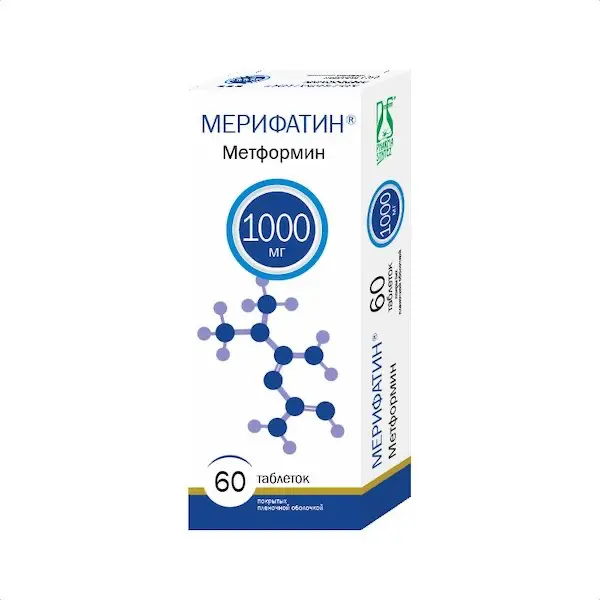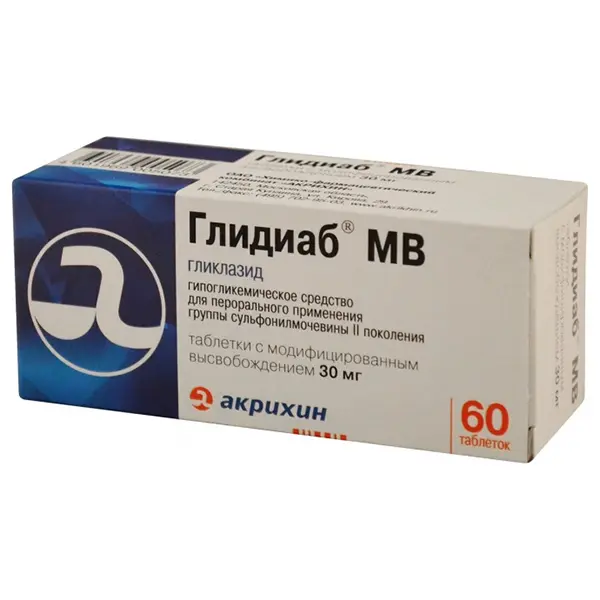Description
Glimepiride Pharmacodynamics
Glimepiride reduces blood glucose concentration, mainly due to stimulation of insulin release from pancreatic beta cells. Its effect is mainly due to an improvement in the ability of pancreatic beta cells to respond to physiological glucose stimulation.
Compared to glibenclamide, taking low doses of glimepiride causes the release of less insulin while achieving approximately the same decrease in blood glucose concentrations. This fact is evidence in favor of the presence of extrapancreatic hypoglycemic effects of glimepiride (increased tissue sensitivity to insulin and insulinomimetic effect).
Insulin secretion. Like all other sulfonylurea derivatives, glimepiride regulates insulin secretion by interaction with ATP-sensitive potassium channels on beta-cell membranes. Unlike other sulfonylurea derivatives, glimepiride selectively binds to a protein with a molecular weight of 65 kDa located in the membranes of pancreatic beta cells. This interaction of glimepiride with the protein that binds to it regulates the opening or closing of ATP-sensitive potassium channels.
Glimepiride closes potassium channels. This causes depolarization of beta cells and leads to the opening of volt-sensitive calcium channels and the entry of calcium into the cell. As a result, increased intracellular calcium concentration activates insulin secretion by exocytosis.
Glimepiride binds to and is released from the binding protein much faster and thus more frequently than glibenclamide. It is assumed that this property of glimepiride’s high exchange rate with its binding protein accounts for its pronounced effect in sensitizing beta cells to glucose and protecting them from desensitization and premature depletion.
The effect of increasing tissue sensitivity to insulin. Glimepiride enhances the effects of insulin on glucose uptake by peripheral tissues.
Insulinomimetic effect. Glimepiride has effects similar to those of insulin on glucose uptake by peripheral tissues and glucose exit from the liver. Glucose uptake by peripheral tissues is carried out by its transport inside muscle cells and adipocytes. Glimepiride directly increases the number of glucose transporting molecules in the plasma membranes of muscle cells and adipocytes. Increased intracellular glucose entry leads to activation of glycosylphosphatidylinositol-specific phospholipase C. As a result, intracellular calcium concentration decreases, causing a decrease in protein kinase A activity, which in turn leads to stimulation of glucose metabolism.
Glimepiride inhibits glucose excretion from the liver by increasing the concentration of fructose-2,6-bisphosphate, which inhibits gluconeogenesis.
Effect on platelet aggregation. Glimepiride reduces platelet aggregation in vitro and in vivo. This effect appears to be associated with selective inhibition of cyclooxygenase, which is responsible for the formation of thromboxane A, an important endogenous factor of platelet aggregation.
Antiatherogenic effect of the drug. Glimepiride promotes normalization of lipids, reduces malonic aldehyde in blood, which leads to a significant reduction in lipid peroxidation. In animals glimepiride leads to a significant reduction in the formation of atherosclerotic plaques.
Reducing the severity of oxidative stress, which is constantly present in patients with type 2 diabetes. Glimepiride increases endogenous α-tocopherol, catalase activity, glutathione peroxidase and superoxide dismutase.
Cardiovascular effects. Through ATP-sensitive potassium channels (see above), sulfonylurea derivatives also have cardiovascular effects. Compared with conventional sulfonylurea derivatives, glimepiride has significantly less effect on the cardiovascular system, which may be explained by the specific nature of its interaction with the ATP-sensitive potassium channel protein that binds to it.
In healthy volunteers, the minimum effective dose of glimepiride is 0.6 mg.
Indications
Type 2 diabetes mellitus (in monotherapy or in combination therapy with metformin or insulin).
Contraindications
– Type 1 diabetes mellitus;
– diabetic ketoacidosis, diabetic precoma and coma;
– Severe hepatic dysfunction (no experience with clinical use);
– severe renal dysfunction, including in patients on hemodialysis (lack of experience with clinical use);
– lactose intolerance, lactase deficiency, glucose-galactose malabsorption;
– pregnancy;
– breastfeeding;
– children under 18 years of age;
– Hypersensitivity to glimepiride or to any inactive component of the drug, to other sulfonylurea derivatives or to sulfonamides (risk of hypersensitivity reactions).
Caution:
– In the first weeks of treatment (increased risk of hypoglycemia).
– In the presence of risk factors for hypoglycemia (see section “Special indications”, adjustment of the glimepiride dose or the entire therapy may be required).
– In case of intercurrent diseases during treatment or in case of changes in the patients’ lifestyle (change of diet and time of meals, increase or decrease of physical activity).
– In glucose-6-phosphate dehydrogenase deficiency.
– In disorders of absorption of food and drugs in the gastrointestinal tract (GIT) (intestinal obstruction, intestinal paresis).
Pregnancy and lactation:
Glimepiride is contraindicated for use in pregnant women. In case of a planned pregnancy or if pregnancy occurs, the woman should be transferred to insulin therapy.
Glimepiride penetrates into breast milk, so it should not be taken during breastfeeding. In this case it is necessary to switch to insulin therapy or stop breastfeeding.
Dosage and administration
- Tablets of the drug Glimepiride are taken orally, whole, without chewing, with plenty of fluid (about 0.5 glasses). If necessary, the tablets may be divided along the risk into two equal parts.
- As a rule, the dose of Glimepiride is determined by the target blood glucose concentration. The lowest dose sufficient to achieve the required metabolic control should be used.
- During treatment with Glimepiride, blood glucose concentration should be determined regularly. In addition, regular monitoring of glycated hemoglobin is recommended.
Incorrect intake of the drug, for example, skipping another dose, should never be compensated by taking a subsequent higher dose. - The patient’s actions in case of errors in taking the medication (in particular skipping the next dose or skipping meals) or in situations where it is not possible to take the medication should be discussed between the patient and the physician in advance.
- Initial dose and dosage selection
The initial dose is 1 mg of glimepiride once a day.
If necessary, the daily dose may be gradually (at intervals of 1-2 weeks) increased. It is recommended to increase the dose under regular control of blood glucose concentration and according to the following dose increase step: 1 mg-2 mg-3 mg-4 mg-6 mg-(8 mg). - Dose range in patients with well-controlled diabetes mellitus
The usual daily dose in patients with well-controlled diabetes is 1-4 mg of glimepiride. A daily dose greater than 6 mg is more effective only in a small number of patients. - Dosing regimen
The time of taking the drug and the distribution of doses during the day is set by the doctor depending on the patient’s lifestyle at a given time (time of meals, amount of physical activity). - Usually it is enough to take the drug once a day. It is recommended that in this case the entire dose of the drug is taken immediately before a full breakfast or, if not taken at that time, immediately before the first main meal. It is very important not to skip meals after taking the pills.
- Since improvement of metabolic control is associated with increased insulin sensitivity, the need for glimepiride may decrease during treatment. In order to avoid the development of hypoglycemia, it is necessary to reduce the dose or discontinue the drug Glimepiride in a timely manner.
- Conditions in which it may also be necessary to adjust the dose of the drug:
– decrease in body weight;
– Lifestyle changes (changes in diet, time of meals, amount of physical activity);
– occurrence of other factors which lead to predisposition to development of hypoglycemia or hyperglycemia (see section “Special indications”). - Duration of treatment
Treatment with the drug Glimepiride is usually carried out for a long time.
Transfer of a patient from another hypoglycemic agent for oral use to administration of Glimepiride - There is no exact correlation between the doses of Glimepiride and other hypoglycemic agents for oral use. When another oral hypoglycemic drug is replaced with Glimepiride, it is recommended that its initial dose should be the same as the initial prescription of Glimepiride, i.e., treatment should start with a low dose of 1 mg (even if the patient is transferred to Glimepiride from the maximum dose of another oral hypoglycemic drug). Any dose increase should be carried out in stages, taking into account the effectiveness of glimepiride in accordance with the above recommendations.
- It is necessary to take into account the strength and duration of the effect of the preceding oral hypoglycemic drug. Treatment may need to be interrupted in order to avoid any “summation of effects, which may increase the risk of hypoglycemia.
- Use in combination with metformin
In patients with insufficiently controlled diabetes when taking maximum daily doses of glimepiride or metformin, treatment with a combination of these two drugs may be initiated. In this case, previous treatment with glimepiride or metformin is continued at the same dose level, and additional administration of metformin or glimepiride is started with a low dose, which is then titrated according to the target level of metabolic control up to the maximum daily dose. Combination therapy should be started under close medical supervision. - Use in combination with insulin
Patients with insufficiently controlled diabetes mellitus while taking maximum daily doses of glimepiride may be simultaneously prescribed insulin. In this case, the last dose of glimepiride prescribed to the patient remains unchanged. In this case, treatment with insulin begins with low doses, which are gradually increased under the control of blood glucose concentrations.





